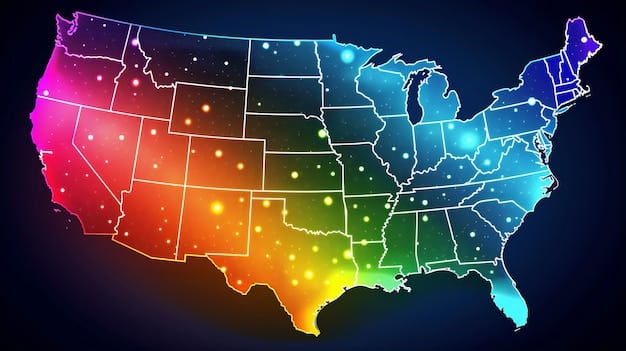Autonomous Vehicle Regulations in the US: The Future of Transportation

The Future of Transportation: Understanding Autonomous Vehicle Regulations in the US requires examining the evolving legal landscape, technological advancements, and ethical considerations shaping the integration of self-driving vehicles into American society.
The advent of autonomous vehicles promises a revolution in transportation, but navigating the regulatory landscape in the US is crucial for understanding the Future of Transportation: Understanding Autonomous Vehicle Regulations in the US. As self-driving cars edge closer to becoming a mainstream reality, the patchwork of federal, state, and local laws presents both opportunities and challenges for automakers, tech companies, and the public.
Understanding the autonomous vehicle revolution
The autonomous vehicle revolution is not just about cars that drive themselves; it represents a fundamental shift in how we perceive and interact with transportation. As technology continues to advance, understanding its implications becomes increasingly vital.
Technological advancements driving autonomy
The rapid pace of technological advancement is the primary driver behind the autonomous vehicle revolution. Developments in artificial intelligence, sensor technology, and connectivity are making self-driving cars safer and more efficient.
- Artificial Intelligence (AI): AI algorithms are the brains of autonomous vehicles, enabling them to perceive their surroundings, make decisions, and navigate complex environments.
- Sensor Technology: LiDAR, radar, and cameras provide a comprehensive view of the vehicle’s surroundings, allowing it to detect objects, pedestrians, and other vehicles.
- Connectivity: Real-time data from other vehicles, infrastructure, and cloud-based services enhances situational awareness and enables coordinated movement.

These technological advancements are converging to create vehicles that can operate without human intervention, promising increased safety, reduced traffic congestion, and improved accessibility for people with disabilities.
In summary, the autonomous vehicle revolution merges artificial intelligence with sophisticated sensors and connectivity to produce self-driving cars that promise increased safety, smoother traffic flow, and broader accessibility.
Federal guidance on autonomous vehicles
The federal government plays a crucial role in shaping the regulatory landscape for autonomous vehicles. While states have traditionally held primary responsibility for vehicle regulation, the federal government provides guidance and sets safety standards that influence the development and deployment of self-driving cars across the nation.
NHTSA’s role in autonomous vehicle regulation
The National Highway Traffic Safety Administration (NHTSA) is the primary federal agency responsible for regulating vehicle safety. NHTSA has issued voluntary guidance documents aimed at promoting a consistent national framework for autonomous vehicle regulation.
- AV START Act: This proposed legislation seeks to establish a federal framework for autonomous vehicle regulation, preempting state laws that unduly restrict the development and deployment of self-driving cars.
- Voluntary Guidance: NHTSA has issued several rounds of voluntary guidance, outlining best practices for autonomous vehicle safety and encouraging manufacturers to self-certify their vehicles’ compliance with federal safety standards.
- Rulemaking Authority: NHTSA retains the authority to issue mandatory safety standards for autonomous vehicles, including requirements for crashworthiness, occupant protection, and cybersecurity.
These federal efforts aim to strike a balance between promoting innovation and ensuring safety, providing a framework for the responsible development and deployment of autonomous vehicles.
In conclusion, federal guidance via the NHTSA, legislation like the AV START Act, and the potential for mandatory safety standards collectively aim to ensure safety and foster innovation in autonomous vehicle development.
State-level regulations: a patchwork approach
While the federal government provides overarching guidance, much of the regulatory authority for autonomous vehicles resides at the state level. This has resulted in a patchwork of laws and regulations across the country, with some states actively encouraging autonomous vehicle testing and deployment, while others take a more cautious approach.

Key state regulations and legislation
Several states have emerged as leaders in autonomous vehicle regulation, enacting comprehensive laws that address issues such as testing, licensing, and liability.
California, for example, has some of the most comprehensive regulations in the nation, requiring autonomous vehicle manufacturers to obtain permits for testing and deployment and setting detailed safety standards.
Nevada was one of the first states to authorize the testing of autonomous vehicles on public roads, and it has since enacted laws addressing issues such as liability and insurance.
Florida has also been proactive in promoting autonomous vehicle technology, enacting legislation that allows for the operation of self-driving cars without a human driver present, subject to certain safety requirements.
These state-level initiatives reflect a diverse range of approaches to autonomous vehicle regulation, highlighting the need for greater harmonization and coordination across jurisdictions.
In short, state-level regulations on autonomous vehicles range from comprehensive laws addressing testing and deployment to more cautious approaches, reflecting the need for harmonization across jurisdictions.
Insurance and liability considerations
One of the most complex challenges in regulating autonomous vehicles is determining liability in the event of an accident. Traditional insurance models, which are based on driver fault, may not be appropriate for self-driving cars, which are programmed to make decisions based on complex algorithms.
Who is responsible when an autonomous vehicle crashes?
Determining liability in autonomous vehicle accidents requires careful consideration of the roles of the vehicle manufacturer, technology provider, and vehicle owner or operator.
- Product Liability: If an accident is caused by a defect in the vehicle’s design or manufacturing, the manufacturer may be held liable under product liability laws.
- Negligence: If an accident is caused by the negligence of the vehicle owner or operator, such as failing to properly maintain the vehicle or overriding its autonomous functions, they may be held liable.
- Cybersecurity: If an accident is caused by a cybersecurity breach that compromises the vehicle’s systems, the technology provider may be held liable.
As autonomous vehicles become more sophisticated, new insurance models may be needed to address the unique liability risks they pose.
Essentially, determining liability in autonomous vehicle crashes requires evaluating product defects, operator negligence, and cybersecurity breaches, potentially necessitating new insurance models.
Ethical dilemmas in autonomous vehicle programming
Beyond legal and regulatory considerations, autonomous vehicles raise complex ethical dilemmas that must be addressed in their programming and deployment. Self-driving cars must be programmed to make split-second decisions in potentially life-or-death situations, forcing engineers to grapple with difficult moral choices.
The trolley problem and autonomous vehicles
The trolley problem, a classic thought experiment in ethics, highlights the challenges of programming autonomous vehicles to make ethical decisions.
Imagine a self-driving car is faced with a situation where it must choose between two unavoidable outcomes: swerving to avoid hitting a group of pedestrians, but in doing so, hitting a single pedestrian in the other lane; or continuing straight, hitting the group of pedestrians. How should the car be programmed to respond in this situation?
There is no easy answer to this question, and different people may have different opinions on what the “right” choice is. However, it is essential that these ethical dilemmas are carefully considered and addressed in the development of autonomous vehicle technology.
Therefore, the programming of autonomous vehicles involves addressing ethical dilemmas like the trolley problem, requiring developers to make challenging moral choices in potentially life-or-death situations.
The future of autonomous vehicle regulations
As autonomous vehicle technology continues to evolve, the regulatory landscape will need to adapt to keep pace. This will require ongoing collaboration between federal and state governments, industry stakeholders, and the public to ensure that autonomous vehicles are safe, reliable, and accessible to all.
Potential regulatory changes and trends
Several potential regulatory changes and trends could shape the future of autonomous vehicle regulation.
- Federal Preemption: The federal government may seek to preempt state laws that unduly restrict the development and deployment of autonomous vehicles, establishing a more uniform national framework.
- Performance-Based Standards: Regulators may shift away from prescriptive design standards and toward performance-based standards that focus on achieving specific safety outcomes, allowing manufacturers more flexibility in their designs.
- Data Sharing: Regulators may require autonomous vehicle manufacturers to share data on accidents and near-misses, enabling them to identify safety trends and improve vehicle performance.
These regulatory changes could pave the way for the widespread adoption of autonomous vehicles, transforming the way we live, work, and travel.
In conclusion, the convergence of federal preemption, performance-based standards, and data sharing could significantly shape the future of autonomous vehicle regulation, paving the way for broader adoption and transforming our approach to transportation.
| Key Point | Brief Description |
|---|---|
| 🚗 Autonomous Tech | AI, sensors, and connectivity drive self-driving capabilities. |
| ⚖️ Federal Guidance | NHTSA provides voluntary guidelines and potential safety standards. |
| 🗺️ State Regulations | A patchwork of laws exists, with some states leading the way. |
| 🤔 Ethical Issues | The “trolley problem” exemplifies dilemmas in AV programming. |
Frequently Asked Questions
▼
Currently, the US lacks a unified federal standard, leading to a state-by-state regulatory approach. This patchwork can complicate the deployment and testing of autonomous vehicles across different regions.
▼
Engineers and ethicists are collaborating to develop algorithms that prioritize safety and minimize harm in unavoidable accident scenarios, although these solutions are still evolving.
▼
Liability can fall on various parties, including manufacturers, technology providers, or even vehicle owners, depending on the cause of the accident, such as a defect or improper maintenance.
▼
NHTSA provides guidance and has the authority to set federal safety standards for autonomous vehicles, aiming to balance innovation with safety through voluntary guidelines and potential mandatory rules.
▼
Future trends may include federal preemption to standardize regulations, performance-based standards focusing on safety outcomes, and data sharing requirements to improve vehicle performance and safety.
Conclusion
Navigating the Future of Transportation: Understanding Autonomous Vehicle Regulations in the US requires a comprehensive understanding of the technological advancements, ethical dilemmas, and the evolving legal landscape. As autonomous vehicles move closer to mainstream adoption, addressing these challenges will be crucial for ensuring their safe and responsible integration into society.





